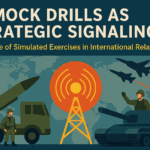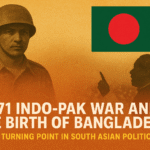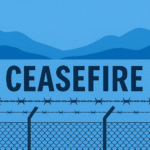India-US Relations
India and the United States, two of the most influential democracies in the world, have traversed a long and complex path to reach the stage of a robust strategic partnership. While one is the oldest democracy and the other the largest, the evolution of their bilateral relations reflects the growing convergence of political ideals, strategic interests, and global responsibilities. In the contemporary geopolitical climate—rife with uncertainty, terrorism, technological competition, and power shifts—this relationship has acquired greater significance. This article explores how India and the US share common democratic values, a joint commitment to counterterrorism, and a mutual need to come closer as they navigate the future of global politics.
I. Historical Overview: From Hesitation to Cooperation
Early Cold War Divergence
In the early decades following India’s independence in 1947, India-US relations were characterized more by distance than closeness. The Cold War dichotomy forced alignments, and while India pursued a policy of Non-Alignment, the US tilted towards Pakistan as a strategic partner. This created mistrust and limited bilateral cooperation.
Post-Cold War Realignment
The 1991 collapse of the Soviet Union and India’s economic liberalization marked a turning point. As India opened up to global markets, its strategic importance rose in Washington. The landmark moment came in 2005 with the signing of the India-US Civil Nuclear Agreement, which symbolized a paradigm shift—recognizing India as a responsible nuclear power and deepening strategic ties.
II. Shared Values: Democracy, Rule of Law, and Pluralism
India-US relations are bound by a shared commitment to democracy, civil liberties, and pluralism. As the world’s oldest and largest democracies, they embody the aspirations of over 1.6 billion people for free expression, participatory governance, and justice.
- Democratic Institutions: Both countries have institutional checks and balances, constitutional frameworks, and an independent judiciary that upholds the rule of law.
- Freedom of Expression: Despite challenges, freedom of the press, civil society activism, and political diversity remain core tenets in both democracies.
- Pluralistic Societies: India’s multi-religious, multi-ethnic identity finds resonance with America’s multiculturalism. Both nations celebrate diversity as strength.
This alignment in political values forms a strong foundation for diplomatic and cultural engagement and makes their partnership ideologically robust in the global context.
III. A Common Enemy: The Fight Against Terrorism
One of the most significant convergences in India-US relations is shared commitment to combating terrorism.
India’s Long Battle with Terrorism
India has been at the receiving end of cross-border terrorism for decades—be it the 1993 Bombay blasts, the 2001 Parliament attack, or the 2008 Mumbai attacks. India’s fight against terrorism is not just a national struggle but a fight against global extremism, with strong international implications.
America’s War on Terror
Since the September 11, 2001 attacks, the United States has been at the forefront of a global war against terrorism. With its global military presence and intelligence capabilities, the US plays a critical role in dismantling terror networks and disrupting transnational extremism.
Strategic Cooperation
India and the US have increasingly collaborated on intelligence sharing, counterterrorism training, cyber security, and financial tracking of terrorist activities. Initiatives such as the US-India Counterterrorism Joint Working Group, Homeland Security Dialogue, and cooperation through QUAD have fortified their anti-terror alliance.
IV. Economic and Technological Interdependence
Growing Trade and Investment
Bilateral trade in goods and services has surpassed $190 billion annually, making the US one of India’s largest trading partners. American companies see India as a massive market, while Indian businesses contribute significantly to the US economy—especially in sectors like IT, pharmaceuticals, and engineering.
Technology and Innovation
- Digital Partnership: India’s robust IT sector and growing startup ecosystem complement US leadership in innovation and technology. Collaborations in artificial intelligence, space, quantum computing, and cybersecurity are gaining momentum.
- Semiconductors and Supply Chains: Amid rising tensions with China, the US and India are increasingly focusing on resilient and secure supply chains. Initiatives like the India-US Critical and Emerging Technology (iCET) dialogue demonstrate their intent to co-develop technologies vital for future security and growth.
V. Defense and Strategic Convergence
Defense Agreements
Over the last two decades, the two countries have signed multiple foundational defense agreements:
- LEMOA (2016) – Allows mutual logistical support during joint exercises and humanitarian missions.
- COMCASA (2018) – Enables secure communication between their militaries.
- BECA (2020) – Facilitates real-time sharing of geospatial intelligence.
Military Exercises
Joint military exercises such as Yudh Abhyas, Tiger Triumph, and Malabar (with Japan and Australia) have enhanced operational coordination and interoperability.
Indo-Pacific Strategy
Both India and the US share concerns over China’s assertiveness in the Indo-Pacific. The QUAD (Quadrilateral Security Dialogue) is a testament to their vision of a free, open, and rules-based Indo-Pacific, grounded in international law and democratic norms.
VI. Geopolitical Alignments in a Multipolar World
A Shift from Unipolarity to Multipolarity
The global order is shifting from a US-dominated unipolar structure to a multipolar world with rising powers like China, India, and the EU shaping geopolitics. In this context, the India-US relations gains importance not as one of dominance, but as a partnership of equals.
Regional Balancing
- China’s Rise: Both India and the US perceive China’s rise, especially its assertiveness in Asia, as a strategic challenge. Cooperation in maritime security, regional diplomacy, and economic counterbalances is essential.
- Russia Factor: While India maintains historical ties with Russia, the US understands India’s need for strategic autonomy. This maturity in mutual expectations ensures that the partnership is not transactional but strategic.
VII. People-to-People and Academic Ties
The Indian diaspora in the United States—numbering over 4.5 million—is a vital bridge between the two nations. They contribute significantly to America’s scientific, academic, medical, and tech sectors.
- Educational Exchange: Over 200,000 Indian students study in the US every year, fostering academic and cultural ties.
- Shared Innovation Ecosystems: Cross-border collaborations between universities, research institutes, and tech companies enhance mutual understanding and development.
VIII. Climate Change and Global Health
Environmental Cooperation
India and the US have reaffirmed their commitment to tackling climate change through initiatives like the U.S.-India Climate and Clean Energy Agenda 2030 Partnership. The transition to green energy, sustainable development, and technological innovations in clean energy are mutual priorities.
Pandemic Cooperation
The COVID-19 pandemic revealed the vulnerabilities of even the most powerful nations. The US provided aid during India’s second wave, while India, through its pharmaceutical industry, supported global vaccine supplies. Future global health partnerships will be vital for preparedness and equity.
IX. Challenges in the India-US relations
Despite the broad-based cooperation, challenges in the India-US relations remain:
- Trade Barriers: Tariff disputes and protectionist policies sometimes strain economic relations.
- Strategic Autonomy vs Alliance Expectations: India values its strategic autonomy, whereas the US often expects clearer alignment, especially in multilateral situations like the Russia-Ukraine conflict.
These differences, while real, have not derailed the strategic trajectory, indicating maturity in bilateral engagement.
X. The Road Ahead: A Strategic Necessity
As the global power matrix becomes more unpredictable, India and the US will increasingly find each other indispensable. The future of international relations is likely to be shaped by:
- Strategic convergence over Indo-Pacific security
- Shared interest in counterterrorism and global peace
- Joint leadership on climate and technological innovation
- The need for multilateral reforms and democratic resilience
In India-US relations, mutual respect for national interests, transparency in diplomacy, and stronger institutional partnerships will be essential for building a resilient alliance.
Conclusion
India and the United States are not just strategic partners by convenience; they are allies by conviction. Their shared democratic ethos, joint battle against terrorism, and overlapping strategic interests in a rapidly changing world necessitate deeper collaboration. The 21st century poses challenges that no country can face alone—be it climate change, terrorism, pandemics, or technological disruption.
As the oldest and largest democracies, India and the US must rise to the occasion and lead by example—by strengthening their alliance, respecting their differences, and working together to uphold the values of freedom, peace, and human dignity. The future of global politics will not be defined by power alone, but by principled partnerships—and the India-US relationship is a cornerstone of that vision.
As the world’s largest and oldest democracies, India and the United States bring together not just their populations, but their shared commitment to freedom, pluralism, and the rule of law. Their partnership goes far beyond symbolic alignment—it is rooted in concrete cooperation against terrorism, expanding economic ties, technological innovation, and mutual interests in ensuring a free and open Indo-Pacific region. In a world increasingly defined by multipolarity, cyber threats, and geopolitical instability, both nations find in each other a natural ally—capable of amplifying their global influence while promoting democratic resilience. Together, they are better positioned to shape a more secure, just, and inclusive international order.





